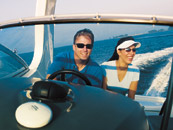On a long cruise over open water, standing at the helm keeping your boat pointed in the right direction can grow wearisome, making the whole process of going for a boat ride seem a lot like work.
Sure, you can trade off your boat driving duties with another crewmember, but sometimes this isn’t practical if you’re short-handed—or feasible, if the substitute helmsman lacks the boat-handling skills. Wouldn’t it be neat if your boat could drive itself—at least once in a while?
Autopilot
Enter the autopilot. Think of an autopilot as a virtual crewmember that you don’t have to feed or listen to whine and complain when the going gets tough.
An autopilot consists of a navigational component that processes information from your boat’s compass or GPS (and other electronic navigation devices), and a mechanical system to move the boat’s rudder/steering gear. In the most basic of terms, you tell the autopilot where you want to go, the autopilot determines which way the boat should be headed, and in turn, commands the mechanical system to change the rudder’s position accordingly.
For automated helmsman’s duties, an autopilot is a great choice for powerboats and many sailboats—but sailboats can use a completely different method for steering the boat that’s simple and doesn’t require electronics—or electricity.
Self-Steering Gear
Because sailboats use the wind as their primary source of propulsion, maintaining a steady course while under sail often involves deviating from the course a little bit one way or another to compensate for minor changes in wind direction.
Self-steering gear is an ingenious mechanical device that often uses a wind vane (wind direction sensor) instead of a compass to tell the steering system which way to move the rudder. First, you point the boat in the direction you’d like to go, position the sails for maximum efficiency, and then engage the self-steering mechanism.
If the wind shifts, the wind vane also moves, which then adjusts the rudder position accordingly. No, your boat won’t stay 100% on a given compass heading, but it will keep sailing towards your final destination.
